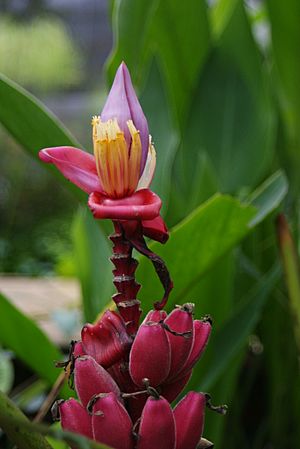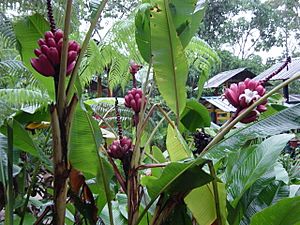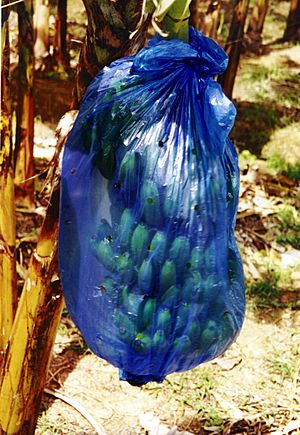Banana production in Ecuador facts for kids
Banana production in Ecuador is super important for the country's economy. Ecuador is one of the world's top banana producers, making about 8 million tons each year. That's about 6% of all bananas grown globally! The country sends out over 4 million tons of bananas to other countries every year. Most bananas are grown on private farms. These farms then sell their bananas to big companies like Chiquita, Del Monte, Dole, and Noboa.
Contents
A Look Back: Banana History in Ecuador
Growing bananas in Ecuador started around 1910. But the industry really took off after 1948. That's when President Galo Plaza's government helped farmers. They offered loans, built roads and ports, and worked on controlling pests.
In the mid-1950s, Ecuador was the biggest banana producer in the world! By 1954, a few large companies handled most of Ecuador's banana exports. Ten years later, there were 3,000 banana farms across the country. Each farm was quite large, about 158 acres on average. By 1960, Ecuador was producing 25% of the world's bananas. This was more than all the Central American countries combined.
In the late 1950s, a plant disease called Panama disease caused big problems. It destroyed many banana crops. In the 1960s, changes in land ownership happened. Also, some big international companies left because of worker issues. This led to many smaller farms being started by local growers. During this time, Central American countries started growing a new type of banana called Cavendish. This was a challenge for Ecuador. However, Dole helped Ecuador keep its share of the world market.
In 1974, Ecuador joined the Union of Banana Exporting Countries. This group tried to get better prices for bananas. But their idea for an export tax didn't work out in Ecuador. The group later faced problems due to a bribery scandal.
Later, another banana disease called Black sigatoka spread. It badly affected banana farms in Central America and Colombia. This, along with political issues in Central America, actually helped Ecuador. Big companies like Standard Fruit and Del Monte decided to get most of their bananas from Ecuador in the 1970s. About 147,909 hectares (that's a lot of land!) were used for growing bananas. Most of these farms were in the lowlands near the Pacific Coast. This area has a tropical climate and rich soil, which is perfect for bananas.
In the 1980s and 1990s, Ecuador changed its trade rules. This helped banana exports grow even more. Bananas made up 21.1% of all exports and 64.7% of all farm exports in the 1990s. By 1998, nearly 5,000 banana farmers employed 98,000 workers. In 1999, Dole opened a new shipping port called Bananapuerto.
In 2012, Ecuador lost about $600 million because of the Black sigatoka fungus. About 40% of the country's banana farms were affected.
How Bananas Are Produced
Growing bananas depends a lot on natural resources and workers. The price of bananas can change a lot in the world market. This affects how much is produced. What people want to buy, trade rules, and environmental rules also play a big role. The trade policies of the European Union also influence banana production.
In 2000, Ecuador exported almost 4 million metric tons of bananas. This was 28% of the world's total banana exports. Bananas were Ecuador's second biggest export after oil. They made up 5% of the country's total economic output. Most of these bananas went to the United States (24%). The European Union was the next biggest buyer (17%).
Ecuador grows about 300 types of bananas. But the most common one is the Cavendish. These bananas can be grown close together. However, they can easily get pests, mold, and other diseases. So, farmers often spray them with chemicals to keep them healthy and get good harvests.
Bananas are harvested almost every week of the year. A new banana plant grows from the root of an old one. It takes about a year for the new plant to start producing fruit. Once harvested, the bananas are quickly sent to their destinations by truck.
Growing bananas involves several steps. Farmers remove weeds and spray insecticides. They cover the fruits with plastic to protect them. Sometimes, plastic bags filled with insecticide are put around the bananas. Wooden stakes are used to support the plants. Farmers also remove yellow and dead leaves. They use colored bands to track the growth stages of the plants. This helps them know when to harvest the fruit, send it to the packing plant, and cut the remaining stems.
Banana Dishes in Ecuador
Ecuador's food includes many different types of bananas. Oritos are sweet baby bananas. They are short, fat, and very sweet. Another related fruit, plantains (called plátanos), are also widely grown. Plantains are usually cooked before eating, whether they are green or ripe.
In coastal areas, a popular side dish is Patacones, which are fried plantains. Plantains can be deep-fried, baked, or boiled and used in many dishes. Green plantains are unripe and called verde. As they ripen, they turn yellow, then black. Green plantains are often cut into thin slices and deep-fried. These are called chifles and are very popular, like potato chips. They are often eaten with ceviches and other meals. The maqueño type is especially good for chifles. Viche is a soup that includes banana, seafood, and peanuts.
Environmental and Worker Safety Concerns
Growing bananas can sometimes cause environmental problems. One issue is dealing with plastic bags. These bags are tied to the plants and fruits as they grow. Blue bags, in particular, can contain harmful chemicals. These chemicals can spread into the environment.
Insecticides are often sprayed from airplanes about 25 times a year. This is a big concern because people working on the farms can be exposed to these chemicals. Not only the farms, but also homes, animals, and water can be affected by the spray. Tests of water samples have shown harmful substances. These substances can cause health problems. When workers spray by hand, the impact can be even greater. Sometimes, contractors hire workers who don't have proper protection. These workers might use very strong chemicals.
To help with these issues, a program called Corporate Social Responsibility (CSR) has been started. However, its success has been questioned. The FAO has suggested a "Health, Safety & Environment Programme" for the banana industry. This program would focus on worker safety and environmental protection.
Exposure to harmful pesticides is a risk for all workers, including children. Some reports have found children as young as 8 working in banana production. According to Human Rights Watch, Ecuador has not always protected workers' rights to form unions. The U.S. Department of Labor reported in 2013 that 2.7% of children aged 5 to 14 were working. Most of these children (71%) were in agriculture, including banana production. In 2014, bananas from Ecuador were mentioned in a list of goods produced by child labor.




